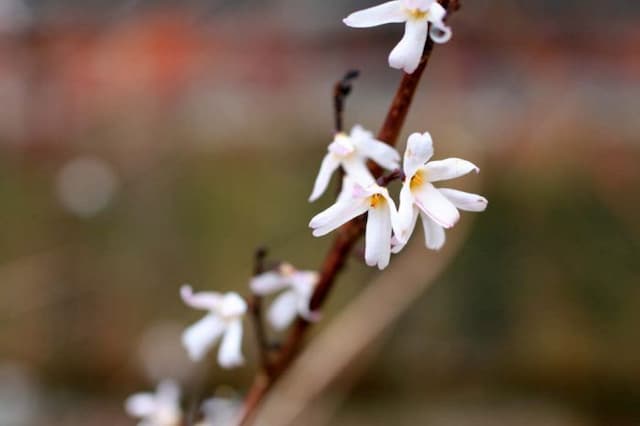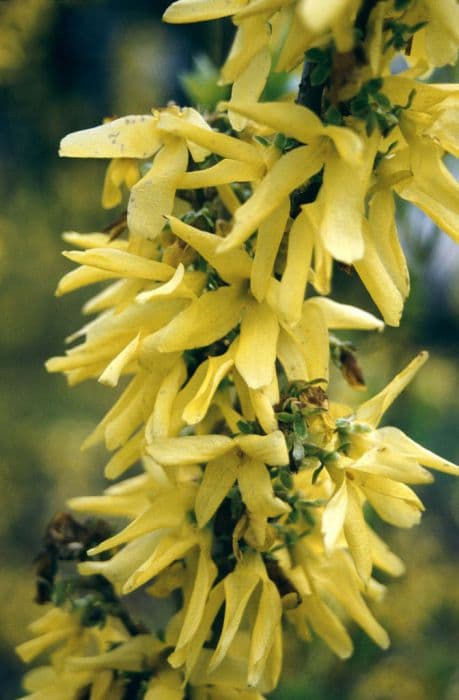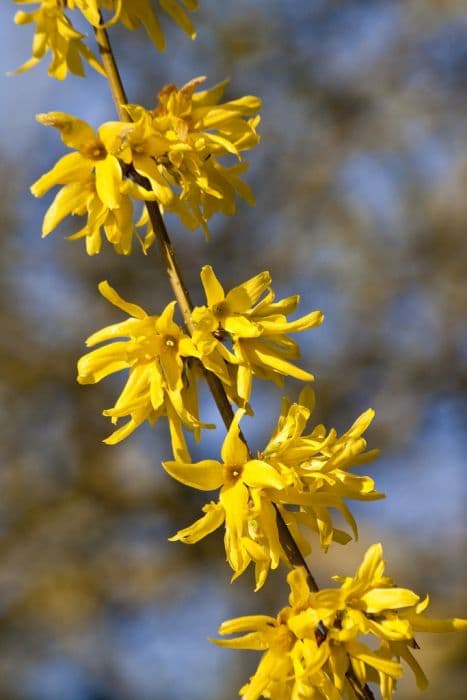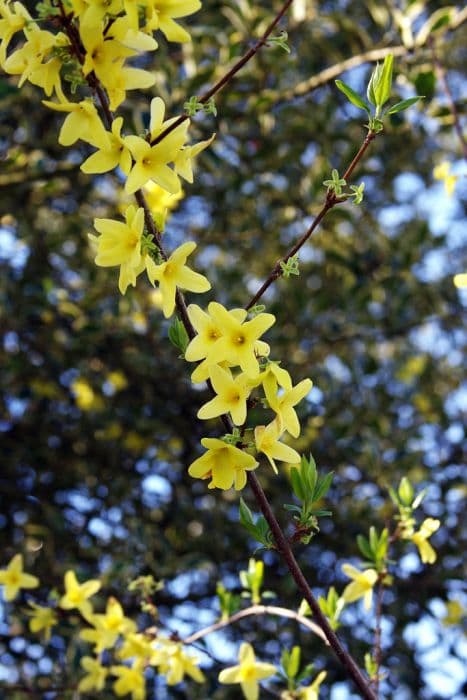Winter Jasmine Jasminum nudiflorum
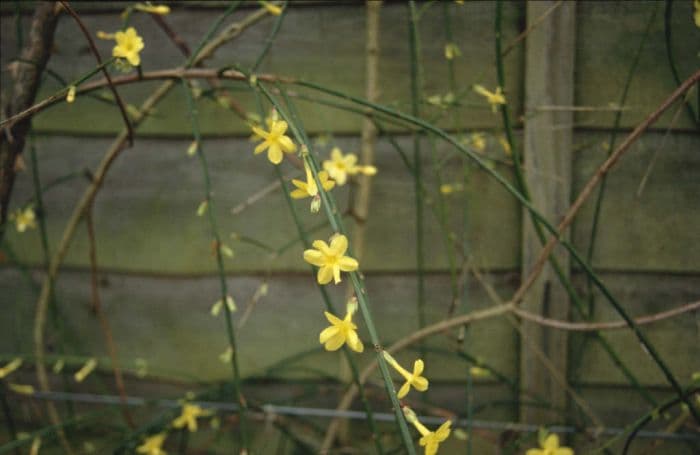
ABOUT
Winter jasmine, known more widely by its common name as the winter jasmine, is a plant that captivates with its bright and cheerful appearance, particularly remarkable during the colder months. As its name suggests, it is among the few plants that bloom in winter, adding a touch of warmth to otherwise bleak landscapes. The winter jasmine has slender, green stems that elegantly arch and spread. It often has a fountain-like growth habit, which allows it to grace garden spaces with a natural, unstructured form. During the flowering season, from late winter to early spring, the branches of this plant become adorned with an abundance of small, bright yellow flowers. These flowers are star-shaped and provide a striking contrast against the dark, leafless branches from which they emerge. The leaves of winter jasmine are compound, meaning they are made up of multiple leaflets arranged along a central stem. Each leaf typically consists of three leaflets that are dark green in color and have a shiny surface. The leaflets are simple in shape and ovate, with a smooth edge that contributes to the plant's overall delicate and refined look. Relative to other jasmines, the winter jasmine is less fragrant, but what it lacks in scent, it makes up for in visual appeal. It can be grown on trellises, walls, or allowed to sprawl as ground cover, depending on the gardener's aesthetic preference. In a cultivated setting, winter jasmine is appreciated for its versatility and its ability to bring color to gardens when most other plants are dormant. Its resistance to cold temperatures and its innate charm make it a beloved choice for gardeners looking to enhance their outdoor spaces with year-round interest.
About this plant
 Names
NamesFamily
Oleaceae
Synonyms
Winter Jasmine, Winter-Flowered Jasmine
Common names
Jasminum sieboldianum.
 Toxicity
ToxicityTo humans
Winter Jasmine (Jasminum nudiflorum) is not known to be toxic to humans. Therefore, accidental ingestion of parts of this plant does not typically cause poisoning or adverse health effects. However, it is always prudent to avoid eating plants not meant for consumption.
To pets
Winter Jasmine (Jasminum nudiflorum) is generally considered non-toxic to pets. Cats, dogs, and other household pets are not likely to suffer from poisoning if they ingest parts of this plant. As with any non-food plant, ingestion can sometimes lead to mild gastrointestinal upset due to the novelty of the plant material, but toxicity is not a concern with this species.
 Characteristics
CharacteristicsLife cycle
Perennials
Foliage type
Deciduous
Color of leaves
Green
Flower color
Yellow
Height
10 feet (3 meters)
Spread
8 feet (2.4 meters)
Plant type
Shrub
Hardiness zones
6
Native area
China
Benefits
 General Benefits
General Benefits- Ornamental Appeal: Jasminum nudiflorum, commonly known as winter jasmine, adds visual interest to gardens with its bright yellow flowers that bloom in late winter to early spring.
- Winter Interest: One of the few plants that flower during the winter months, providing color and vibrancy when most other plants are dormant.
- Erosion Control: Its vigorous growing habit and ability to spread means it can help stabilize soil and prevent erosion on slopes or banks.
- Low Maintenance: Winter jasmine requires minimal care once established, making it a suitable choice for gardeners of all experience levels.
- Drought Tolerance: Once established, it can survive periods of low water, which is beneficial in drought-prone regions or for water-wise gardening.
- Wildlife Attraction: While it is not the most prolific nectar source, its early flowers can provide an important early-season food source for bees and other pollinators.
- Versatility: It can be grown as a shrub or trained to climb walls and trellises, offering flexibility in garden design and use of space.
- Fast Growth: The plant grows quickly, allowing for rapid coverage of trellises, walls, or other structures in the garden.
- Propagates Easily: Winter jasmine can be easily propagated from cuttings, making it simple to create more plants for use in other areas of the garden.
 Medical Properties
Medical PropertiesThis plant is not used for medical purposes.
 Air-purifying Qualities
Air-purifying QualitiesThis plant is not specifically known for air purifying qualities.
 Other Uses
Other Uses- Winter Jasmine (Jasminum nudiflorum) can be used as a natural dye for fabrics, offering a greenish-yellow color when the stems and flowers are processed.
- Its pliable stems can be woven into decorative baskets or other intricate craft items, leveraging the plant's flexibility when it is young.
- The plant can serve as a habitat and source of nectar for early-spring insects, as it blooms in late winter when few other nectar sources are available.
- Winter Jasmine can be trained to grow over arbors or pergolas, providing a winter interest in gardens or outdoor spaces.
- Cuttings from Winter Jasmine make attractive indoor decorations, with their bright yellow flowers offering a splash of color during the winter months.
- The plant's extensive root system can help in soil stabilization on slopes, potentially preventing soil erosion in certain environments.
- As a photography subject, Winter Jasmine’s vivid yellow flowers against barren landscapes can create striking contrast, especially appreciated in the minimalist art community.
- Winter Jasmine’s resilient nature can make it a contender for use in bonsai, especially for practitioners interested in flowering species.
- The bright flowers can be floated in bowls of water for a simple and elegant tabletop decoration, especially popular in East Asian aesthetics.
- The blossoms can be incorporated into wreaths and other floral arrangements for a touch of winter vibrancy, often mixed with evergreens for contrast.
Interesting Facts
 Feng Shui
Feng ShuiThe Winter Jasmine is not used in Feng Shui practice.
 Zodiac Sign Compitability
Zodiac Sign CompitabilityThe Winter Jasmine is not used in astrology practice.
 Plant Symbolism
Plant Symbolism- Friendship: Jasminum nudiflorum, commonly known as winter jasmine, is often associated with the warmth and affection present in friendships, providing comfort during the cold winter months.
- Beauty: With its bright yellow blooms that contrast the bleak winter landscape, the winter jasmine symbolizes beauty, reminding us that charm and elegance can thrive even in challenging conditions.
- Renewal: As one of the few plants that bloom in winter, winter jasmine is a symbol of renewal and hope, representing the idea that life continues and rejuvenates even after periods of dormancy or hardship.
- Optimism: The burst of color from its flowers during the grey winter season makes the winter jasmine a symbol of optimism, as it brings a sense of positivity and the anticipation of spring.
- Warmth: Winter jasmine's ability to flower in cold temperatures is also symbolic of warmth, both physical and emotional, suggesting the presence of affection and care during tough times.
 Water
WaterWinter Jasmine should be watered deeply but infrequently, as the plant is quite drought-tolerant once established. During the growing season (spring and summer), water approximately every 7 to 10 days, adjusting for rainfall and temperature. Provide about 1 to 1.5 gallons per watering for each mature shrub to ensure that the water penetrates deeply into the soil. In the fall, reduce watering to encourage the plant to harden off for winter, and during winter, only water if there are extended dry periods. It's critical not to overwater, as this can lead to root rot.
 Light
LightWinter Jasmine prefers full sun to partial shade. The best spot for the plant would be one where it receives at least 4 to 6 hours of direct sunlight a day, although it can tolerate some light shade, especially in hot climates. A location that gets morning sun and afternoon shade could be ideal to protect from the intense heat of late day.
 Temperature
TemperatureWinter Jasmine is hardy and can tolerate temperatures down to about 10 to 15 degrees Fahrenheit, but it thrives best in temperatures ranging from 60 to 75 degrees Fahrenheit. The maximum temperature it can handle without stress is around 90 degrees Fahrenheit. It's a robust plant that can handle the varying temperatures of temperate climates very well.
 Pruning
PruningWinter Jasmine should be pruned in spring, right after it finishes flowering, to maintain its shape and encourage vigorous growth. Prune out any dead or damaged wood, and trim back shoots that have flowered to a strong set of buds. Annual pruning not only helps maintain an attractive shape but also improves the plant's overall health and flowering for the next season.
 Cleaning
CleaningAs needed
 Soil
SoilWinter Jasmine thrives in well-draining soil with a mix of loam, sand, and organic matter. Aim for a soil pH of 6.0 to 7.5 for optimal growth.
 Repotting
RepottingWinter Jasmine should be repotted every 2 to 3 years or when it outgrows its current pot to ensure continued health and growth.
 Humidity & Misting
Humidity & MistingWinter Jasmine prefers moderate humidity but is adaptable to a range of humidity conditions commonly found in home environments.
 Suitable locations
Suitable locationsIndoor
Place Winter Jasmine in bright light; water when top soil feels dry.
Outdoor
Plant Winter Jasmine in partial shade to full sun; shelter from harsh winds.
Hardiness zone
6-9 USDA
 Life cycle
Life cycleWinter Jasmine, Jasminum nudiflorum, begins its life cycle when a seed germinates, usually in spring under favorable conditions of moisture and temperature. The seedling develops into a young plant with a primary root and juvenile shoots, which mature during the growing season. As the plant grows, it develops long, slender, arching green shoots that start to form buds in late summer or early autumn. These buds remain dormant over the winter and burst into a vibrant display of yellow flowers, often by late winter or early spring, before the leaves appear. After pollination, typically by insects, the flowers develop into black berries containing seeds, thus completing the reproductive cycle. As a perennial, Winter Jasmine then enters a period of vegetative growth each year, preparing for the next cycle of bloom.
 Propogation
PropogationPropogation time
Spring
Winter jasmine, known botanically as Jasminum nudiflorum, is most commonly propagated by layering. The optimal time for this method is late winter or early spring, just before new growth begins. To propagate by layering, a long, flexible stem is bent to the ground and a portion of it is covered with soil, leaving the tip exposed. This buried section should be slightly wounded or nicked and then anchored down, perhaps with a wire loop or a heavy stone. Over time, roots will form at the point of soil contact. Once the new plant has established a sufficient root system, which can be checked by gently tugging on the stem to feel for resistance, it can be severed from the parent plant with pruners and transplanted to a desired location. This simple and effective technique utilizes the parent plant's resources until the new jasmine is ready to flourish on its own.
